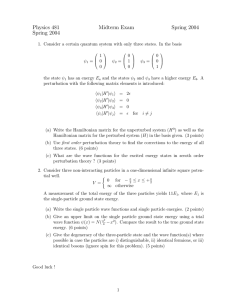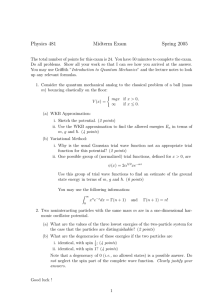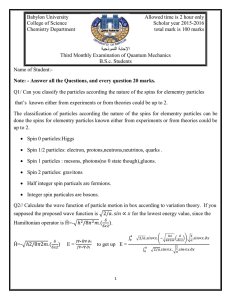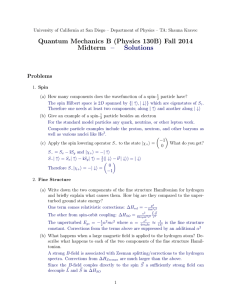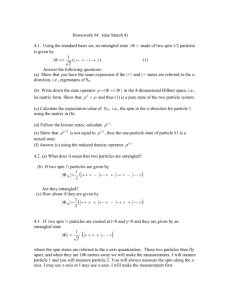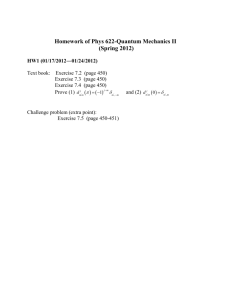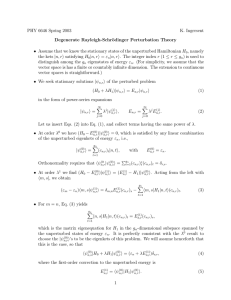PS405 Midterm
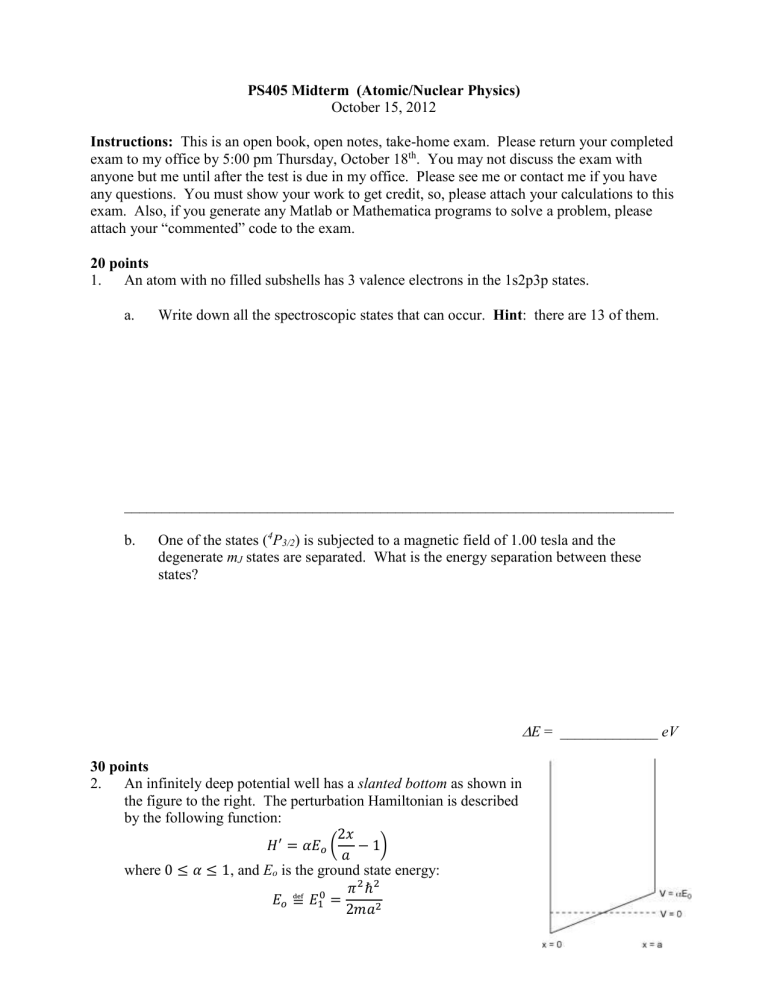
PS405 Midterm (Atomic/Nuclear Physics)
October 15, 2012
Instructions: This is an open book, open notes, take-home exam. Please return your completed exam to my office by 5:00 pm Thursday, October 18 th
. You may not discuss the exam with anyone but me until after the test is due in my office. Please see me or contact me if you have any questions. You must show your work to get credit, so, please attach your calculations to this exam. Also, if you generate any Matlab or Mathematica programs to solve a problem, please attach your “commented” code to the exam.
20 points
1. An atom with no filled subshells has 3 valence electrons in the 1s2p3p states. a. Write down all the spectroscopic states that can occur. Hint : there are 13 of them.
_________________________________________________________________________ b. One of the states ( 4 P
3/2
) is subjected to a magnetic field of 1.00 tesla and the degenerate m
J
states are separated. What is the energy separation between these states?
30 points
2. An infinitely deep potential well has a slanted bottom as shown in the figure to the right. The perturbation Hamiltonian is described by the following function:
𝐻
𝐸
′ 𝑜
= 𝛼𝐸
≝ 𝐸 𝑜
0
1
(
2𝑥 𝑎
= 𝜋
− 1)
2𝑚𝑎 2 where 0 ≤ 𝛼 ≤ 1 , and E o
is the ground state energy:
2 ℏ 2
E = _____________ eV
a. Calculate the first order correction to all the unperturbed energy states 𝐸
(0) 𝑛
.
𝐸 𝑛
(1)
= __________ 𝛼𝐸 b. Calculate the second order correction to the unperturbed ground state energy 𝐸
1
(0)
Sum from m = 2 through 20.
.
0
𝐸
1
(2)
= ______________ 𝛼 2 𝐸
0
c. Calculate the first order correction to the ground state wave function 𝜓
1
(1)
Once again, sum from m=2 through 20 . Plot 𝜓 𝜓
(1)
1
(0)
1
from 0 → 𝑎, assuming
. 𝜶 = 𝟎. 𝟓 .
Plot the unperturbed probability density 𝜓
1 density 𝜓 ∗
1 𝜓
1
where 𝜓
1
= 𝜓
(0)
1
+ 𝜓
(1)
1
(0)∗
on top of the
, in the interval 0 ≤ 𝑥 ≤ 𝑎 corrected probability assuming 𝜶 = 𝟎. 𝟓 .
d. How well normalized is the corrected wave function 𝜓
1
= 𝜓
(0)
1
+ 𝜓
(1)
1
?
Probability ( 0 → 𝑎 ) = __________ % e. Calculate the probability of finding the particle in the infinitely deep potential well with the perturbed Hamiltonian in the region 0 → 𝑎
2
and in the region 𝑎
2 corrected ground-state wave function calculated above, 𝜓
1
.
→ 𝑎 using the
Probability ( 0 → 𝑎
) = __________ %
2
Probability ( 𝑎
2
→ 𝑎 ) = __________ % f. Why is the second order perturbation energy in part (b) negative?
20 points
3. Two identical non-interacting particles move independently in an infinitely deep onedimensional well of length a . One particle is in the ground state and the other is in the first excited state. Assume that the particles are spin ½ and are in a triplet spin state. a. Write the spatial part of the normalized wave function describing these two spin ½ particles. 𝜓
𝑆𝑝𝑎𝑡𝑖𝑎𝑙
= ___________________________________________________________________________ b. Plot the probability density (𝜓
∗ 𝑠𝑝𝑎𝑡𝑖𝑎𝑙
𝜓 𝑠𝑝𝑎𝑡𝑖𝑎𝑙
) as a function x
1
and x
2
, the onedimensional coordinates of particles 1 and 2 respectively, in the intervals 0 → 𝑎 .
Note: This is a 3-dimensional plot. c. What is the mean separation of these two spin ½ particles?
Calculate: ⟨𝐷⟩ = ⟨|𝑥
1
− 𝑥
2
|⟩
⟨𝐷⟩ = ⟨|𝑥
1
− 𝑥
2
|⟩ = __________ 𝑎
